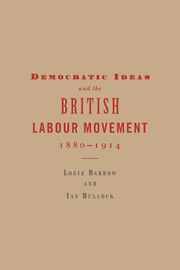1 - The survival of Chartist assumptions
Published online by Cambridge University Press: 09 November 2009
Summary
This chapter discusses one small and one tiny organisation: the Social Democratic Federation (SDF) and its short-lived child, the Socialist League. The importance of these organisations, into and beyond the 1900s, lies for us in the growing influence of those they helped to form. Originating in the 1880s – thus encouraging historians to talk of a socialist revival – they were self-consciously in the shadow of Chartism.
Just as the 1940s remain vital for many on the Left today, so the Chartist movement of around the 1840s remained the reference point for generations afterwards. Most relevant for this book, it had aimed to democratise parliament as a precondition for whatever social reforms working people (or rather working men) might next demand.
Into the new century, the SDF weekly Justice saw SDFers as Chartism's ‘legitimate heirs and successors ’. Some of them had themselves been Chartists, among whom James Murray was on the SDF executive in the 1880s still demanding proportio-nal representation and other democratic measures as a way towards the ‘socialisation of production ’.
Not that these had necessarily stood still during the intervening decades. The Birmingham-based John Sketchley had gone through Owenism, freethought and republicanism. On the one hand they were open to Continental influences; Sketchley's 1879 Principles of Social Democracy is credited by E. P. Thompson with introducing European and particularly German socialist ideas to many future British socialists. The French Revolution and 1848 both figured prominently in the socialist calendar.
- Type
- Chapter
- Information
- Publisher: Cambridge University PressPrint publication year: 1996
- 1
- Cited by

